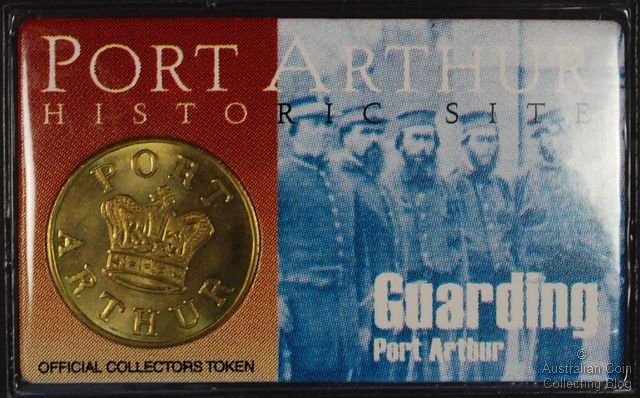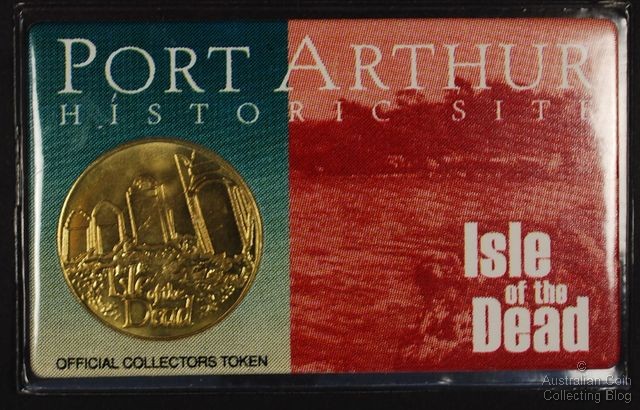November 2009 Archives

Australia 1910 Threepence
2010 marks the 100th anniversary since the first official silver coins minted for the country of Australia were released. At the time, the Australian government decided to adhere to the British Sterling standard and consequently threepence, sixpence, shilling and florins (two shillings) were minted in 92.5% silver. Before the coinage act of 1909 (which decreed Australia should have it's own coinage) the standard coinage in Australia was that of England. English coins had circulated in Australia since colonisation in 1788. Some coins were struck here in Australia prior to 1910 such as the holey dollar and dump and many different unofficial traders tokens usually struck in bronze. Some few tokens were also struck in silver but again these were not official coinage of the land.
These coins were dated 1910 and all carried the portrait of Edward VII on the obverse and the Australian Coat of Arms on the reverse. The portrait of King Edward VII was sculpted by George De Saulles. Interestingly this designer died in 1903, seven years before his designs were introduced onto currency. The reverse design was sculpted by WHJ Blakemore. None of the coins has a mintmark (which first appeared in 1914 when some silver coins were minted at the Heaton mint). No copper coins were struck dated 1910 but they did appear in Australia in 1911. The first silver coinage to arrive in Australia from the Royal Mint in London were shillings in March 1910. Edward VII died in May and the rest of the 1910 silver denominations followed into Australia after his death. 1910 is the only year to carry the portrait of Edward VII as 1911 coins bear the effigy of the new King George V. Coins were not minted in Australia until 1916.
None of the 1910 silver coinage is especially scarce with mintages being reasonably large. Mintages were 4 million for the 3d, just over 3 million for the 6d, 2.5 million for the shilling and the lowest of the series 1.2 million for the florin. As you'd expect the florin is the key to the date set with uncirculated examples very hard to find and worth in excess of $3,000. Uncirculated examples of the other denominations are not so hard to find, with uncirculated examples worth $250, $400, and $700 for the 3d, 6d, and 1s respectively. The Edward VII portrait is notoriously flat and can be very poorly struck up so when evaluating a coin of 1910 this should be taken into account. The coat of arms should be very well struck up on the reverse with full emu feathers, a clear Advance Australia and strong shields. One thing to be wary of with the 1910 coinage (and all older silver coins) is that they may have been rubbed lightly many years ago or suffered cabinet friction. The evidence of this may be well hidden by 90 years of toning so great care should be taken to examine the high points of the coin for such damage.
 2006 Commonwealth Games One Dollar
2006 Commonwealth Games One Dollar2006 saw Melbourne, Australia host the XVIIIth Commonwealth Games in which 71 countries participated in 247 events including aquatics, cycling, gymnastics and shooting. The event was officially opened by her majesty Queen Elizabeth II on 15th March 2006.
These games were the largest sporting event held in Victoria since the 1956 Melbourne Olympic Games and it was a treat for Australians to again have such an event on home soil. Melbourne was awarded the games in 1999 and it took this 7 year period to prepare and build facilities and infrastructure to support the visitor and competitor impact that hosting the Commonwealth games brought to Melbourne and Victoria.
Numerous Royal Australian Mint products were released in many denominations to celebrate this event. One of these releases was a standard 25mm size 9 gram aluminium bronze one dollar coin. This uncirculated dollar coin was not issued into circulation but being of standard size you may well one day find one that someone has spent for a dollar. Issue price in an informative folder was $2.75 with catalogue value well over that now. It proved extremely popular with collectors and overseas visitors as the cheapest coin product available commemorating the games.
The reverse design on this issue was sculpted by Tony Dean. It depicts the symbol of the 2006 Melbourne Commonwealth Games and an M mintmark indicating the games were held in Melbourne. All 58,505 coins were however struck at the Royal Australian Mint in Canberra, not in Melbourne as the mintmark suggests. The obverse features the standard Ian Rank-Broadley effigy of Queen Elizabeth II, who, as head of the commonwealth officially opened the games.
The blog team recently met with designer, engraver and sculptor Tony Dean at his Medal Art Mint facility in the picturesque Bega Valley 400km south of Sydney. Tony Dean is probably best known by collectors of the Coloured Ocean Series of one dollar coins released by the Royal Australian Mint in 2006-2007 and those who possess the $1 and 20c Lifesaver coins released in 2007.
It was at the age of 17 that Tony started as an apprentice to Czech born engraver Emil Hafner in Melbourne where he learnt the basics and techniques to guide him through all facets of creating coins, medals, pins and tokens. With an eye for creativity and graphic design he has been employed by both the Perth Mint and The Royal Australian Mint in Canberra. Stints at both these mints saw Tony design popular coins such as the 1991 State Series Tasmanian $10 coin from the RAM (as Tony Dean-Kellock) and the 1995 Silver Kookaburra specimen issues from the Perth Mint.
A more recent achievement was an invitation to join the RAM team while one of the chief designers was on long service leave in 2006. He was given the task of designing a circulation dollar coin to promote the Year of the Surf Lifesaver. The mint later changed their decision to release this coin into circulation but it made a superb addition to the 2007 year set struck only in proof quality. Tony also designed the Lifesaver 20c issued in the mint set and Australia Post pnc.
During his time at the RAM in 2006 he also created the designs for the Coloured Ocean series of dollars released by the RAM. These pad-printed designs popular with young collectors have a minimal amount of design struck onto the coin and proved a relatively simple graphic design task. An NCLT Commonwealth Games dollar was also issued during this period that was sculpted by Tony.

Tony at work on a design for a Rowing Australia Pin
More recently Tony has chosen a lifestyle change and decided to open a design studio and office called Medal Art Mint on the far south coast of New South Wales. Here he designs and sculpts plaster, plasticine, silicone rubber and epoxy resin model designs to be made into medals, tokens, medallions and plaques. These models are then taken to the workshop facilities to be turned into hobs and dies to then strike the product for the client. Tony has designed commemorative and prize medals, pins and medallions for the CSIRO, the Australian Academy of the Humanities, Rowing Australia and the Singapore Womens Cycling Team just to name a few. These designs vary from the most intricate of pieces to basic geometric shapes.
Medal Art Mint oversees the entire production process. Firstly discussing with the client their ideas, their needs, size, metal type, delivering concept drawings and modelling the medal design in plaster. The plaster is then cast in silicone and the silicone cast into hard epoxy resin which is taken to the workshop to make a master die to then be used to strike the medal. This process in detail can be found in the article: Coin Designers - Tony Dean Part 2. This process can be done for an order of just one unique medal or a production run of a million!
The whole process of hand sculpting and engraving detailed artistic pieces in plaster and metals is a fine art. Add to this the technological processes of the new century. Medal Art Mint and key designer Tony Dean uses traditional skills learnt from a master engraver combined with the latest computer technology to manufacture the most magnificent struck pieces for any special occasion.
We spoke about our visit to medal and coin designer Tony Dean's studio in part 1 of our article about coin designer Tony Dean. In this second part we'll speak about the process that he goes through when designing and manufacturing a new medal.
Initial 2 Dimensional Designs and Sketches
The initial part of the design process is done via sketching or computer aided graphic design. Tony will either hand draw or mock-up various designs using 2d computer software such as Photoshop or Illustrator. This enables him to produce a number of different design alternatives quickly that can be approved or rejected by his clients. They are also easily modified as design improvements and tweaks are trialed and accepted or rejected. Obviously working in 2 dimensions doesn't allow for a true impression of the beauty of a 3 dimensional design but it is much quicker and cheaper method in initial stages of the coin or medal design.

Plaster Model (left), Silicone Mould (right)
Making the Plaster
Once a medal design has been approved in 2 dimensions work begins on sculpting a large model of the medal. The model is made from high grade dental plaster discs that appear to be 8 to 10 times bigger than the final medal size. Three dimensional elements of the design are built up in plasticine on a sheet of glass and a disc of plaster is cast against this model and glass surface to produce a negative image.
Tony can then speed up the sculpting process by making use of a pantograph reducing machine to carve more simple features such as medal rims and lettering in to the plaster model. To do this Tony prints out the features to be added and etches them into a copper template using copper etchants. This template can then be used in the pantograph reducing machine to machine an exact copy (enlarged or reduced as required) of the design into the plaster model. If you're wondering what a pantograph is try taking a look at this what is a pantograph article on Wikipedia. Tony's pantograph has a small motorised machining head on one side to carve out the design features into the plaster. You can see a picture of his machine below.

Pantograph
Tony can go through multiple plaster models to get the design just right. For example it may be easier to sculpt and refine some design elements working on a negative image model, while others may be easier to refine on a positive image model. When he needs to create a new plaster he coats the old one with a separating agent and casts a new disc from dental plaster against it producing a reverse of the model he started with. The very fine nature and high quality of the plaster means no detail is lost by casting new models. Tony takes 1-3 weeks to produce the plasters for a medal. Remember he has to produce a positive plaster for each side of each medal or coin that he designs so the process does take some time. To be honest when we saw the level of detail he puts into the plaster models 1-3 weeks to produce two plasters seemed awfully quick!
Making the Dies
Once the plasters are complete a silicone cast is made from each plaster (you can see one of these silicones in the first image on this page). The silicone mould is used to cast (there certainly is a lot of casting going on!) a hard epoxy resin positive image of each side of the medal or coin. The epoxy resin model is then used in what is known as a 'reducing machine'. A reducing machine is a special machine used in the engraving and coin making industry to accurately reduce and machine a coin or medal design into tool steel. Put simply the machine uses the hard epoxy model as a guide to reduce and engrave the design into steel. The machine will often run for several days and may make several passes over the design using progressively smaller tool heads to refine the design. The design that has been copied into the steel is known as the hob or reduction punch, you can see a hob on the left below.

Hob (left), Die (right)
The hob is inspected closely (under a microscope) for flaws and any last minute modifications made to it using specialised hand tools. It's at this point that any special treatments are made to the design (such as frosting or polishing). Once the hob is accepted it is heat treated and annealed to increase the hardness of the hob. The hob is then pressed (using a hydraulic press) into more tool steel to form a negative image of the design. This process (known as hobbing) may require several steps before the full detail of the design is pressed properly. The steel being pressed may need to be removed and heat treated to remove the effects of work hardening so the design can be achieved properly. For the error collectors among us mis-alignment of the two work peices during multiple hobbing steps can lead to 'doubling' known as hub doubling.

Finished Medals
Once the design is pressed in satisfactorily we have what is known as a die. Please note that in the coin manufacturing process there's a couple of extra steps in here (to create working hobs and production dies). In Tony's low volume medal manufacturing process, however, the die created from the first hobbing process is used to make the medals. The obverse and reverse dies are installed into a coining press and medal blanks (Tony has minted medals from copper, bronze, silver and gold) are struck to produce the medal. Any post production finishes are then applied to the medals (such as antiquing, electroplating and so on). It is also at this stage that other components may be added to the medal such as ribbon hangers. Above you can see two finished versions of the same medal.

Hand Cut Hob
Hand Cut Hobs
As mentioned in the first part of this article Tony learned his art under the tutelage of Emil Hafner. While there Tony would actually engrave the hobs directly rather than working in plaster. This required the use of special engraving tools, a microscope, and mind boggling skill and care. Obviously tool steel is much harder to work in that plaster, and one mistake could mean starting from scratch! Above you can see one of the hand cut hobs that Tony has created.
In conclusion we'd like to thank Tony for allowing us to visit him at his company's premises and for taking up so much of his time. Tony was very forthcoming and open about his experience and the design process that he goes through. We were certainly amazed at his skill and the beauty of some of his designs and found everything to be extremely interesting. If you're in the market for a medal or plaque he's happy to work with anyone in Australia and working remotely with customers seems to pose no challenge to him. His company has access to all the equipment required to see the medal making process through from concept to striking and delivery of the final product. With Tony designing the medals you have access to a truly world class designer, after all it's not often you can get access to the skills of someone who designed a number of Australian $1 coins! Don't forget to go take a look at his web site: Medal Art Mint.
In September 2009 Richard Welling of Ye Olde Coin Company posted a message on the eBay forums informing the community of a flurry of fake 1934-35 Melbourne Centenary Florins that had been sold on eBay. None of these coins were sold indicating that they were counterfeits and one can only assume the buyers of the coins thought they were real and as such they sold for several hundreds of dollars each. With a few dozen of these fakes selling we are talking about many thousands of dollars being fraudulently gained at the expense of coin collectors. Richard was kind enough to lend us one of these fake florins for comparison with a real florin. We're happy to be able to present to you what we've found.

Counterfeit 1934-35 Centenary Florin

Genuine 1934-35 Centenary Florin
The first thing to be noted about the fake florins is that they are of remarkably good quality and would fool a less experienced collector who wasn't taking too much notice. They are struck rather than cast, and the method used to create the dies was clearly a more advanced technique can the usual investment casting or hand cutting methods. Let's look at how you can pick the real deal from one of these well made fakes.
Weight
An uncirculated florin weighs 11.31g and the fake florin weighs 11.10g. Now 0.21g doesn't sound like a lot but you'd be surprised how little weight a coin loses as it wears. We weighed a mid grade (very fine) florin and the weight was 11.27g, so a worn coin with significant detail missing was just 0.04g lighter! Apparently the fake coin is made from something other than silver to show such a large weight difference.
General Lack of Detail

While the fake florin (seen left) does show good detail, when examined closely it shows a coarseness of character that misses out a lot of the fine design features that the real coin exhibits. The image above shows the fake on the left and clearly much of the detail at the top of the king's crown is simply missing or coarsely struck when compared with the real coin.
The King's Cloak

Some of the detail on the back of the King's cloak is simply missing on the counterfeit coin when compared with the real coin. Seen above you can see that the back of the cloak extends all the way to the rim on the real coin whereas the fake coin on the left has the cloak stopping some way short. You can also see that the fold is missing completely from the counterfeit coin.
The King's Nose

The end of the King's nose is significantly different on the counterfeit florin when comparing it with a genuine coin. Seen above the counterfeit coin on the left shows a rounded nose tip while the real coin shows a clear point.
Legend Lettering

One general observation of the lettering on the fake coin is that it is generally thicker and less refined than that of the real coin. Above you can see the IA dot M from the reverse of the coin. Clearly the lettering is not only less refined than that of the real coin but fish tailing on the bottom of the letters of the genuine article is absent from the fake. Note also that the dot separating the letters is clearly a circle on the fake while the other is clearly an oval.
Missing Design Elements

We managed to identify several missing design elements on the fake coin but these were mostly minor, however some of the streamers around the riders head on the reverse provide a strong indicator between the two coins. On the image above you can clearly see a streamer behind the riders head that is not present on the fake coin. The streamers in front of the riders head are extremely flat and coarse on the fake coin compared with the real coin. Care must be taken with using the flatness of the riders head as an indicator as very poorly struck (but genuine) Centenary Florins can exhibit a rounded and nearly smooth riders head.
General Weakness of Central Strike and Odd Colouration

One of the stronger indicators of the fake coin is the general weakness of strike in the central areas of the coin on both sides. Above you can see how the riders hand has nearly disappeared and that the horses stomach is very flat. This image also shows the strange colour that the fake coin shows in areas of weakness. This colour can best be described as very faintly green grey and is very different to any colour we've ever seen on a florin before.
Conclusions
The fact that fake key date coins are now being sold on eBay makes it important that all collectors educate themselves adequately before making large purchases. Hopefully this article has armed you with the information required to determine if the coin you're looking to purchase is one of the recently appearing fakes. If you're at all unsure either buy your coin from a reputable coin dealer or get one that is graded and certified by a reputable third party grading company. Again thanks to Richard Welling of Ye Olde Coin Company for the loan of the fake coin.
These official collectors tokens can be picked when visiting the Port Arthur (Tasmania, Australia) site. They are collectable really only for their souvenir value and a sentimental reminder of your holiday or trip away. Interesting items to pick up if you have interest in this area. All tokens are 29mm in diameter, uncirculated and protected in a pvc plastic sleeve.
Port Arthur Historic Site Collector token.
This token is one in a series of collector tokens purchased at Port Arthur in Tasmania. This token depicts Convicts.
This token is in an informative card reading:
"Between 1830 - 1877 around 12,500 sentences were served by the convicts sent to Port Arthur for re-offending once they had arrived in Tasmania. Convicts were employed in a wide variety of trades and industries during their sentences in an effort to make the settlement as self sufficient as possible. The combination of isolation hard labour, and the use of leg irons and flogging as forms of punishment were aimed at discouraging inmates from re-offending."
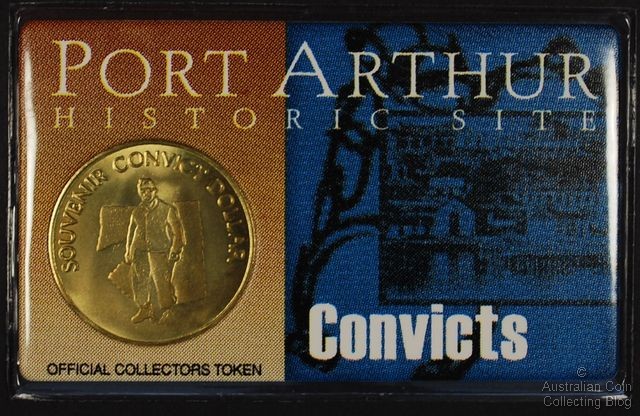
Port Arthur Token - Convicts
Port Arthur Historic Site Collector token.
This token is one in a series of collector tokens purchased at Port Arthur in Tasmania. This token depicts Guarding Port Arthur.
This token is in an informative card reading:
"One of Port Arthurs most important archaelogical discoveries was made in mid 1980's when in the vicinity of the Military Barracks' retaining wall a small uniform button was found. The button provided clear evidence that the penal settlement had it's own militaria-style guard - or at the very least the prison guard or constabulary was issued with a uniform that was unique to the site."
Port Arthur Token - Guarding Port Arthur
Port Arthur Historic Site Collector token.
This token is one in a series of collector tokens purchased at Port Arthur in Tasmania. This token depicts a Convict Love Token.
This token is in an informative card reading:
"Convicts made love tokens soon after hearing about their fate (transportation to the colonies). Love tokens were mainly made from old copper coins, rubbed smooth and then engraved with a message -some only had a few words, while others showed ornate designs. If convicts did not have the skill to engrave the coin themselves they often employed someone else to make them. The tokens were given to their loved ones left behind."
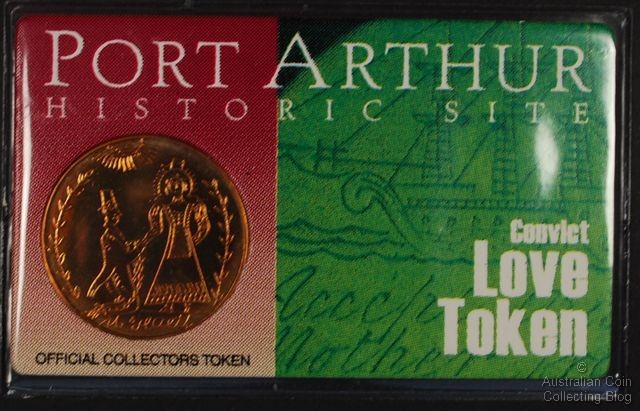
Port Arthur Token -Convict Love Token
Port Arthur Historic Site Collector token.
This token is one in a series of collector tokens purchased at Port Arthur in Tasmania. This token depicts Historic Ghost Tours.
This token is in an informative card reading:
"Since the 1870's countless sightings of apparitions and unexplained happenings have occured at the Port Arthur Historic Site. It is believed that there is a mystical connection at Port Arthur leaving spirits or ghosts of lost souls who have been trapped in an area, unable to rest or unaware they have travelled from the physical world, to occupy the fabric of the historic buildings."
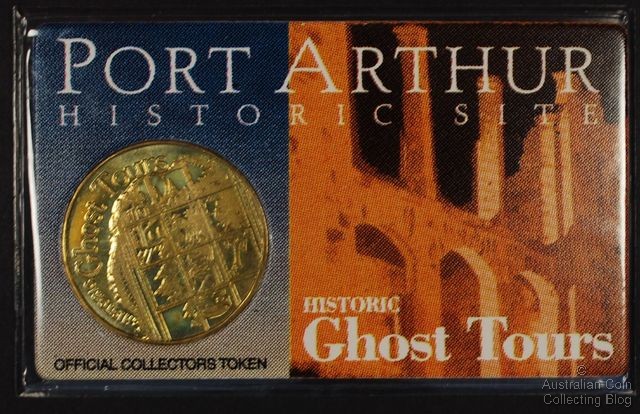
Port Arthur Token - Historic Ghost Tours
Port Arthur Historic Site Collector token.
This token is one in a series of collector tokens purchased at Port Arthur in Tasmania. This token depicts the Cessation of Transportation.
This token is in an informative card reading:
"To celebrate the Cessation of Transportation in 1853, the Anti-transportation League committee ordered the production of a special medallion to comemmorate this important event. 9,000 medallions were struck in pewter and 100 in bronze. The pewter medallions were given to all of the school children in Tasmania in 1855. The medallion also comemmorates the Jubilee of the Founding of Tasmania in 1803."
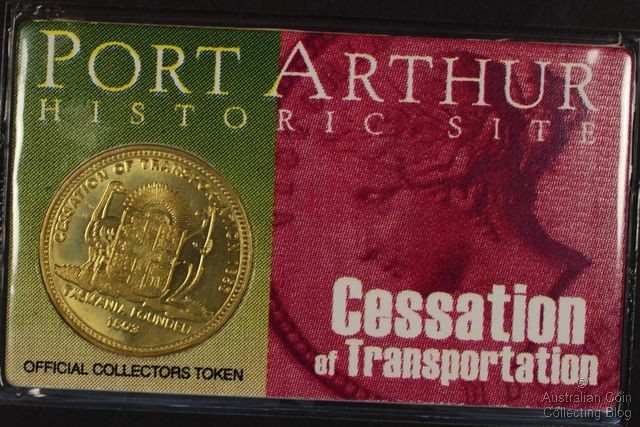
Port Arthur Token - Cessation of transportation
Port Arthur Historic Site Collector token.
This token is one in a series of collector tokens purchased at Port Arthur in Tasmania. This token depicts The Isle of the Dead.
This token is in an informative card reading:
"The Isle of the Dead (or Dead Island) became the burial place at Port Arthur during the 1830's with the first known burial taking place in 1831 when private Joseph Kerr was interred. The island was the final resting place for both convict and free, with the majority of convict graves remaining unmarked. The island continued to be used for burials until 1877."
Port Arthur Token - Isle of the Dead
 1992 Barcelona One Dollar
1992 Barcelona One DollarThis coin was not released into circulation (known as an NCLT issue). It was a standard size 25mm aluminium bronze dollar weighing 9 grams with edge interrupted reeding. The reverse depicts a Javelin thrower sculpted by Margaret Priest with "XXV OLYMPIAD BARCELONA 1 DOLLAR", the legend. The obverse is the Raphael Maklouf effigy of Queen Elizabeth II.
This coin was issued without a mintmark but was available in a number varying packages. It was available at the Mint your Own Gallery Press at the RAM for $2 when you visited Canberra. This was issued in a wallet depicting the RAM building. These were then replaced by wallets with a picture depicting the Olympic rings. The illustrated wallets were also issued at the Sydney Royal Easter Show with a competition entry coupon included.

1992 Barcelona Dollar Aluminium Bronze Proof "Women in Sport"
The RAM also released a special Aluminium bronze proof version (mintage 2,979) which was encapsulated. This version was to highlight women in sport but was abandoned before the commencement of the games and is now quite a scarce issue with a high catalogue value.
The Barcelona $1 was also issued in silver proof which and being silver is heavier at 11.49 grams. It was released in a square box available through the RAM and was also available as a special Coin Fair version which was packaged in a long box. This Coin Fair Silver proof was issued at the NAA (Numismatic Association of Australia) Coin Fair in March 1992 and features continuous reeding around the coin's edge.
The Barcelona $1 can also be found in the One Dollar coin collection together with restrikes of previous years. This is a 5 coin set of dollars in a cardboard folder.
Mintages can be found in the 1991-1995 One Dollar Issues and Mintages table.
 2000 HMAS Sydney II One Dollar
2000 HMAS Sydney II One DollarThe Sydney, a modified Leander class light cruiser was the same class as the English cruisers the Ajax and Achilles which were famous for chasing down the German battleship, the Admiral Graf Spee. While not so famous the Sydney served with great distinction in the Mediterranean and sank an Italian light cruiser, many enemy merchant ships, and took part in several shore bombardments. After Japan entered the war the ship was refitted and sent back to Australia in early 1941 where she was refitted once more and undertook months of patrol and escort activities in the Indian Ocean. In the year 2000 the RAM released a standard Al/Br dollar to remember the 645 Australian sailors who lost their lives on the Sydney, and appropriately the launch ceremony was held on the flight deck of the HMAS Sydney IV on Monday May 8th, 2000.
The obverse of the coin shows the normal Ian Rank-Broadley portrait of QE2, the reverse shows a depiction of the HMAS Sydney II as sculpted by Vladimir Gottwald. The coin minted in the standard 9 gram Aluminium Bronze configuration was available in collector folders with either the C (for Canberra, 86,900 minted) or S (for Sydney, 49,022 minted) mint marks. 2922 of the S mintmark coins were packaged in a specially printed folder for the launch mentioned above but less than 500 were handed out (the exact number is debatable). The balance were returned to the mint for re-packaging. 12,150 of the design were struck in 0.999 pure silver to proof standards and sold in a presentation case.
The VIP launch folder is one of those elusive pieces rarely seen. An S mintmark coin in a special folder marked "The HMAS Sydney II coin launch May 2000" was, at the launch, given to each attendee along with the entire of the ships crew.
In 2008 the Royal Australian Mint released a second series (after the Ocean series) bringing colourful pad-printed designs to the standard 25mm, 9 gram aluminium bronze one dollar circulating coin size. The first releases of this Land Series (2008) were the Echidna, Rock Wallaby, Wombat and the Koala. This continued with the Bilby and Frilled Neck Lizard releases in 2009. This fun and vibrant dollar series presents appeal to younger collectors and incorporates fascinating native Australian animal facts. These reverse designs were all created by Sabina Foster. The coloured design is pad printed on a flat unstruck portion of the planchet with the "1 DOLLAR" and design background being struck on the coin. They all feature a proof obverse, the standard Ian Rank-Broadley effigy of Queen Elizabeth II. Released in an informative collector card these were issued at $14.95.
For the mintages of these issues please see the 2008 Issues and Mintages table and the 2009 Issues and Mintages table.
2008 Uncirculated Echidna
This dollar features the Australian native Short-Beaked Echidna snacking on it's favourite food, ants. It is a small spiny monotreme with long claws and a sticky tongue to collect ants and termites. It is found widespread throughout Australia. The Echidna lays eggs which hatch after 10 days and live in their mothers pouch for 50 days feeding on her milk. A baby Echidna is known as a puggle.
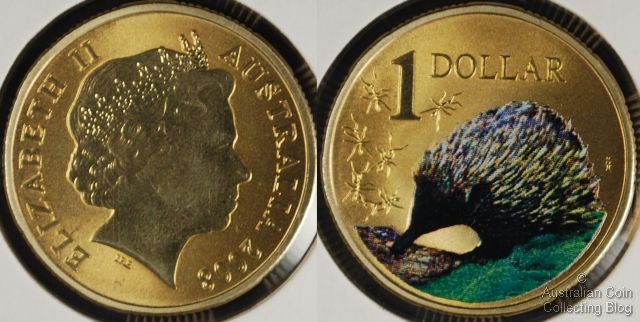
2008 Echidna One Dollar
2008 Uncirculated Rock Wallaby
A Yellow-footed rock wallaby sits comfortably on a rocky outcrop exposing his white underside, yellow forearms, feet and yellow striped tail on this coin design. These wallabies live in rock crevices and caves and can even climb sloping tree trunks. If sensing danger the rock wallaby will stomp the ground with it's hind leg as a warning.
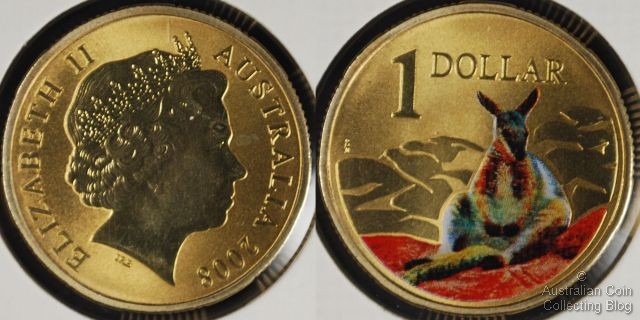
2008 Rock Wallaby One Dollar
2008 Uncirculated Wombat
This common wombat is shown emerging from a hollow log. It is a stout, sturdy marsupial with a large blunt head, short muscular neck and stubby powerful legs. It's found in south-eastern Australia grazing on native grasses, sedges, herbs, bark and roots. The wombat is a powerful digger moving obstacles in their path. The female wombat's pouch faces backwards to protect their young from debris whilst digging.
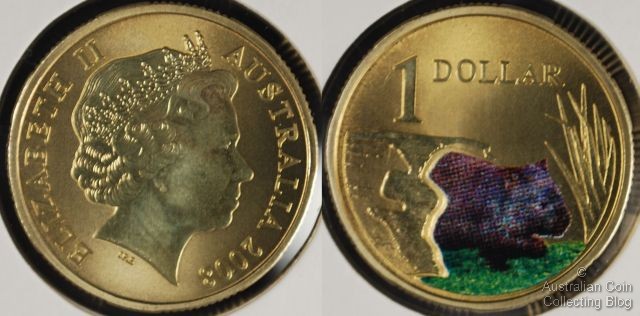
2008 Wombat One Dollar
2008 Uncirculated Koala
The Koala is seen perched in the fork of a Eucalypt tree munching on gum leaves. They are fussy eaters preferring only specific types of gum leaves. Koala's have 2 thumbs on their front paws to help them grip when climbing and eating. Koala's are one of only a few mammals (apart from primates) that have unique fingerprints similar to ours.

2008 Koala One Dollar
2009 Uncirculated Bilby
The Bilby is seen sheltering next to some spinifex grass. The Bilby is a type of bandicoot with soft grey fur, large ears and a black and white-tipped tail. They can be found in mulga shrubland and spinifex grasslands from sw Queensland to northern WA. Bilbies eat seeds, insects, bulbs, fruit and fungi. They live in burrows and have poor eyesight relying on their sense of smell to forage for food.
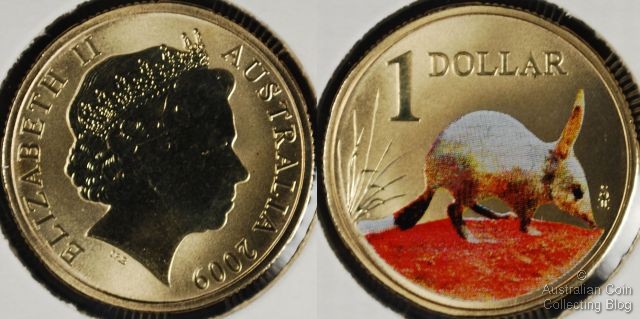
2009 Bilby One Dollar
2009 Uncirculated Frilled Neck Lizard
The Frilled Neck Lizard is shown sitting on a log with the sun and outward radiating circles representing the hot tropical climate where this lizard is found. This Australian native animal (previously found on the 2c piece) is a camouflage colour with a bright neck frill which it displays when alarmed or sensing danger. It hunts in trees for insects and on the ground for termites, ants, spiders and smaller lizards.
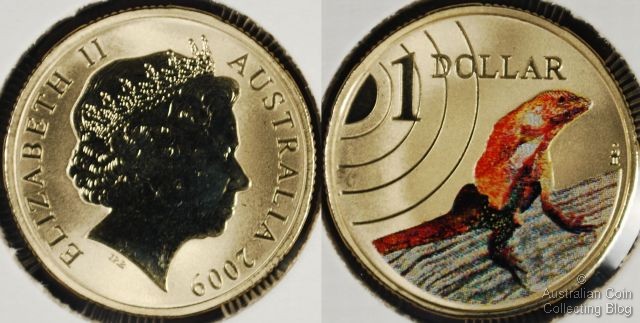
2009 Frilled Neck Lizard One Dollar
 2007 Peacekeeping One Dollar
2007 Peacekeeping One DollarThis standard 25mm size 9 gram aluminium bronze (92% copper, 6% aluminium, 2% Nickel) one dollar coin not issued for circulation commemorates the 60th Anniversary of Australian Peacekeeping. It features the current Ian Rank-Broadley effigy of Queen Elizabeth II. The design sculpted by Caitlan Goodall also features Australian helping hands cradling the globe with an olive branch. A white Dove hovering over completes the symbolism of peace depicted on the coin. 31,028 of these NCLT coins were Issued in a descriptive card for $12.95.
This coin symbolises the courage, professionalism and sacrifices made by Australia's peacekeepers. It's release by the RAM hoped to raise awareness and recognition of this important service.
In 2008 the Royal Australian Mint continued with a plethora of releases of the standard 25 millimetre, 9 gram, aluminium bronze one dollar coin. All Issues feature the standard Ian Rank-Broadley effigy of Queen Elizabeth II. There was a release of standard design mob of roos dollars into circulation as well as a commemorative issue (into circulation) for the Centenary of the Scouting movement. These Scout coins were also available in commemorative RAM wrappered Rolls, the first of such an issue.
2008 brought the introduction of counterstamps and privymarks in addition to mintmarks to help differentiate between where each coin is minted. In 2008 we celebrated the Centenary of the Australian Coat of Arms with C, S, B and M marks. A lovely tribute to the old reverse on all pre-decimal coins minted prior to 1939.
With the success of the pad-printed Coloured Ocean Series of 2006-7, a Land Series was issued for 2008-9. Also a series of "Inspirational Australian's Education" starting with an issue of Mary MacKillop.
2008 was named International Year of Planet Earth with the Mint Set, Proof Set and Fine Silver Year Set issues reflecting this.
| Year | Description | Type | Mint Mark | Composition | Notes | Mintage | 2008 | Mob of Roos | Circulation | None | AlBr | Circulation | 30,106,000 |
| Centenary of Scouting | Circulation | None | AlBr | Circulation | 17,157,000 | |
| Centenary of Scouting | Circulation | None | AlBr | RAM Roll | incl. in above mintage | |
| Coat of Arms Centenary | Circulation | C mm | AlBr | RAM and Dealer Sales | 156,414 | |
| Coat of Arms Centenary | Circulation | C mm | AlBr | RAM Gallery Press | incl. in above mintage | |
| Coat of Arms Centenary | Circulation | C mm | AlBr | Brisbane Coin Fair Overprint Feb | 972 | |
| Coat of Arms Centenary | Circulation | S Privymark | AlBr | RAM and Dealer Sales | 32,529 | |
| Coat of Arms Centenary | Circulation | S Counterstamp | AlBr | Portable Press Sydney Royal Easter Show | 15,836 | |
| Coat of Arms Centenary | Circulation | B Privymark | AlBr | RAM and Dealer Sales | 43,133 | |
| Coat of Arms Centenary | Circulation | B Counterstamp | AlBr | Portable Press Brisbane ANDA Show | 4,029 | |
| Coat of Arms Centenary | Circulation | B Privymark | AlBr | Brisbane Coin Fair Overprint October | 1,100 | |
| Coat of Arms Centenary | Circulation | M Privymark | AlBr | RAM and Dealer Sales | 42,094 | |
| Coat of Arms Centenary | Circulation | M Counterstamp | AlBr | Portable Press Melbourne ANDA Show | 4,004 | |
| Coat of Arms Centenary | Proof | C mm | .999 Silver | Silver Proof Interrupted Reeding | 9,661 | |
| Centenary of Rugby League | Circulation | None | AlBr | RAM and Dealer Sales | 35,282 | |
| Centenary of Rugby League | Circulation | None | AlBr | $1 in Prestige Stamp Booklet by AP | 26,109 | |
| Centenary of Australian Quarantine | Circulation | None | AlBr | RAM and Dealer Sales | 30,094 | |
| Centenary of Australian Quarantine | Circulation | None | AlBr | PNC | 21,600 | |
| Mary MacKillop | Circulation | None | AlBr | Inspirational Australians Education Series | 29,802 | |
| Year of the Rat | Circulation | None | AlBr | Lunar Coin Series | 20,359 | |
| Year of the Rat | Proof | None | .999 Silver | Lunar Coin Series | 5,250 | |
| Koala | Frosted Unc/Proof Rev | None | AlBr | Coloured Land Series | 28,445 | |
| Wombat | Frosted Unc/Proof Rev | None | AlBr | Coloured Land Series | 23,995 | |
| Echidna | Frosted Unc/Proof Rev | None | AlBr | Coloured Land Series | 21,889 | |
| Rock Wallaby | Frosted Unc/Proof Rev | None | AlBr | Coloured Land Series | 25,163 | |
| Norman Lindsay | Circulation | None | AlBr | Magic Pudding Baby Mint Set | 46,504 | |
| Mob of Roos | Circulation | None | AlBr | Mint Set | 63,234 | |
| Mob of Roos | Circulation | None | AlBr | Berlin Money Fair Mint Set | 1,500 | International Year of Planet Earth | Circulation | None | Al Br | 2 Coin Unc Set | 28,399 | International Year of Planet Earth | Proof | None | AlBr | Proof Set | 25,112 | Mob of Roos | Proof | None | AlBr | 2 Coin Proof Set | 11,500 | Mob of Roos | Proof | None | AlBr | Magic Pudding Baby Proof Set | 15,500 | Mob of Roos | Specimen | None | AlBr | Wedding Set | 3,278 | International Year of Planet Earth | Proof | None | .999 Silver | Fine Silver Year Set | 2,600 | International Year of Planet Earth | Proof | None | .999 Silver | Fine Silver Year Set -Berlin Money Fair | 1000 | Mob of Roos | Circulation | None | AlBr | ANZ corporate pack | 202 |
| Centenary of Rugby League | Circulation | None | AlBr | in case | 123 | |
| Koala and Rock Wallaby | Frosted Unc/Proof Rev | None | AlBr | Corporate Pack | 4,942 |
 2005 Gallipoli One Dollar
2005 Gallipoli One DollarANZAC Day, the 25th of April is now the single most important military holiday in both Australia and New Zealand and has surpassed both Remembrance Day and VE/VJ as important days on the calendar. 2005 was the 90th Anniversary of the Gallipoli landings and the RAM was directed to issue a standard 25mm, 9gram aluminium bronze one dollar to celebrate the event. The obverse of the coin depicts the normal Ian Rank-Broadley portrait of QE2, and the reverse depicts a 'digger' in his slouch had with a bugle. Interestingly the reverse was a team effort between the two leading RAM coin designers Vladimir Gottwald and Wojciech Pietranik.
The Gallipoli dollar was minted with several mint marks:
- G (Gallipoli, 40,000 minted),
- C (Canberra, 88,424 minted),
- S (Sydney, 38,965 minted),
- B (Brisbane, 38,719 minted), and
- M (Melbourne, 38,727 minted).
The G mintmark was minted at the RAM and on a portable press at the Australian War Memorial, the S, B, and M mintmarks were also struck at the RAM and portable presses in the respective cities. For the exact split between portable press and normal press mintages please take a look at the 2005 Australian Dollar Coin Issues and Mintages blog entry.
17,749 of the coins were also minted in fine silver to a proof standard. Interestingly there are reported examples of the aluminium bronze coin without the mint mark though these are extremely rare and worth well more than $1,000.
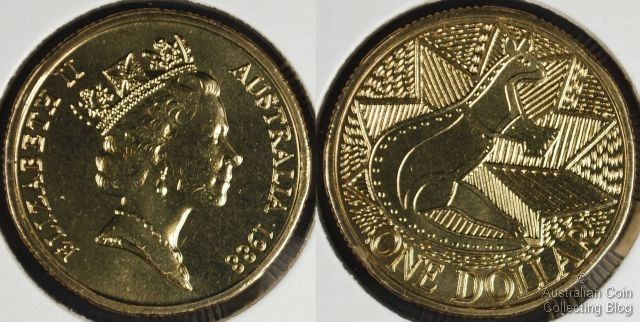
1988 First Fleet Bicentenary One Dollar by Stuart Devlin
1988 brought many celebrations and issues marking 200 years since the First Fleet landed in Port Jackson, Sydney. These ships brought the first immigrants to start the new colony of New South Wales. The First Fleet consisted of 11 ships bringing approximately 1487 people from Great Britain to establish Australia's first European colony. On the 26th January 1788 Fleet leader Captain Arthur Phillip planted the British flag on Australian shore and claimed the land for the British Empire. This day continues to be celebrated as a national holiday Australia Day.
This one dollar issue that entered circulation reminds us of the original Aboriginal inhabitants of our nation. The reverse depicts aboriginal artwork- a stylised kangaroo on a backdrop of a seven pointed (federation) star modeled by designer Stuart Devlin. When we receive one of these in our change, we are reminded of the native Koori people that were displaced by European settlement. This standard 25mm, 9 gram, aluminium bronze dollar features the obverse effigy of Queen Elizabeth II by Raphael Maklouf . 20,400,000 of these coins entered circulation. 3,500 coins were also struck in aluminium bronze proof. This dollar was also restruck later for inclusion in the 5 coin uncirculated set 1988-1992. A sterling silver proof version was also included in the masterpieces in silver set issued in 1990.
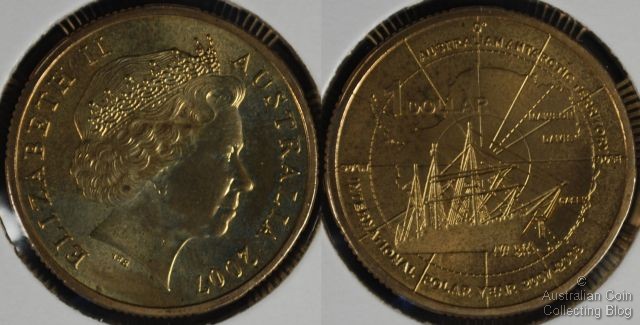
2007 International Polar Year One Dollar
The International Polar Year which ran from March 2007 to March 2009 was a multi national scientific program that focussed on the Arctic and Antarctic. This was the fourth IPY event of the last 150 years and it had particular areas of interest in how polar ice was changing, what impact changes in the polar regions will have globally, how the 4 million people that live in or close to the Arctic regions will be affected, and what can be learned about the planets history from ice records. As the owner of the largest region of the Antarctic (the Australian Antarctic Territory) Australia was a major participant of the IPY and the Australian government legislated that the RAM release a series of coins signifying this. One of these coins was a standard 9.0g, 25mm aluminium bronze dollar that was released in 2007 to the collector community via a NCLT release.
The obverse of the coin shows the Ian Rank-Broadley portrait of the Queen of England. The attractive reverse was modeled by Wojciech Pietranik. It depicts a map of the Antarctic with converging latitude lines and marked with the locations of important Antarctic bases such as Mawson, Davis, and Casey. Overlaying all of this is the image of a 19th century sail powered ice supply ship. 29,893 of these dollars were released to collectors in colourful information cards.

2007 The Ashes One Dollar
In 1882 an Australian cricket team beat the English cricket team on the spiritual home of cricket, Lords. This was the first Australian team to beat an English team in England and the next day saw a mock obituary placed in The Sporting Times (the major sporting newspaper of the time) stating that English cricket had died, and the body would be cremated and the ashes would be taken to Australia. The following year an English cricket team toured Australia in what was dubbed 'the quest to regain The Ashes'. While in Australia the English team was presented with a small ceramic funeral urn that reputedly contained the ashes of a burned cricket bail. This saw the test matches played between England and Australia, now known as 'The Ashes', cemented into the sporting folklore of both countries and the rivalry continues until this very day. 2007 saw the 125th anniversary of the birth of The Ashes and the RAM celebrated this with the release of a standard composition dollar coin. The coin was not released into general circulation and was an NCLT release only.
The obverse of the coin shows the Ian Rank-Broadley portrait of the Queen of England. The reverse, modeled by Wojciech Pietranik, depicts a mock coat of arms with the British Lion and the Australian Kangaroo against a representation of the famous old urn above crossed cricket bats. 41,438 of the Aluminium Bronze dollars were minted into numbered collector cards, and 8,000 were available in the 2007 Ashes PNC.
7,750 coins were minted in 99.9% silver and 2,315 were minted in gold. These were not standard dollar coins in either size, mass, or face value. Interestingly 5 of the silver coins were donated to Cricket Australia for each of the 5 tests of the 2007 Ashes Series. They were specially framed and mounted and auctioned for charity where they achieved prices ranging from $5,000 to $11,000.

2007 APEC Dollar
The obverse of this standard 9 gram, 25mm Aluminium Bronze dollar coin is the Ian Rank-Broadley portrait of Queen Elizabeth II. The reverse is sculpted by Vladimir Gottwald and shows the logo for the Sydney APEC meeting of 2007. It is modeled on the 7 pointed Federation star that can be seen on the Australian flag. The star is made up of 21 boomerangs (a weapon of the native Australian aboriginals) which symbolise the 21 member states of APEC. There was a relatively large number of these coins minted (20,108,00), the majority entering circulation. Uncirculated examples were also available in official RAM rolls (the first such rolls in many years) and some were available in capsules and presentations cases. The coin was not mint-marked.
We were surprised to see exactly how much we've written about the much collected Australian dollar coin and decided it was time to pull all of the information into one blog entry for easy reference. Below you can find links to mintage tables and below those tables you can find links to each of the individual dollar articles we've written in the last year. This entry will be added to as we write more information about the dollar.
1 Dollar Coins Issues and Mintages
Standard circulation size 25 millimetre 9 gram aluminium bronze 1 dollars released by Australia's circulating coin producer, the Royal Australian Mint in Canberra.
1984-1990 Australian 1 Dollar Issues and Mintages
1991-1995 Australian 1 Dollar Issues and Mintages
1996-1998 Australian 1 Dollar Issues and Mintages
1999-2000 Australian 1 Dollar Issues and Mintages
2001 Australian 1 Dollar Issues and Mintages
2002-2003 Australian 1 Dollar Issues and Mintages
2004 Australian 1 Dollar Issues and Mintages
2005 Australian 1 Dollar Issues and Mintages
2006 Australian 1 Dollar Issues and Mintages
2007 Australian 1 Dollar Issues and Mintages
2008 Australian 1 Dollar Issues and Mintages
2009 Australian 1 Dollar Issues and Mintages
2010 Australian 1 Dollar Issues and Mintages
2011 Australian 1 Dollar Issues and Mintages
2012 Australian 1 Dollar Issues and Mintages
2013 Australian 1 Dollar Issues and Mintages
2014 Australian 1 Dollar Issues and Mintages
Articles on the Mob of Roos 1 Dollar Coin
The Standard Iconic Mob of Roos Design One Dollar
Teeny Tiny Mini Money Mob of Roos Gold Dollar 2012
2000 1 Dollar / 10c Mule
2005 Proof Mob of Roos $1: Part 1
2005 Proof Mob of Roos $1: Part 2 -Is it a mule?
2007 Standard Mob of Roos Dollar: Bounding Kangaroo PNC
Articles on Individual Commemorative Coins
1986 International Year of Peace Dollar
1988 First Fleet Bicentenary Dollar
1992 Barcelona Olympic Games Dollar
1993 Landcare Dollar
1994 Dollar Decade 1 Dollar
1995 Waltzing Matilda Centenary Dollar
1996 Henry Parkes Centenary Dollar
1997 Sir Charles Kingsford Smith Birth Centenary Dollar
1998 Lord Howard Florey Birth Centenary Dollar
1999 The Last Anzacs 1 Dollar
1999 International Year of Older Persons 1 Dollar
2000 Olymphilex Dollar
2000 HMAS Sydney II Dollar
2000 The VC Dollar
2001 80th Anniversary of the RAAF Dollar
2001 90th Anniversary of the Navy Dollar
2001 Centenary of Federation Dollar
2001 Centenary of the Australian Army Dollar
2001 International Year of Volunteers Dollar
2002 Year of the Outback Dollar
2003 Australias Volunteers Dollar
2003 Centenary of Women's Suffrage Dollar
2003 Korean War Dollar
2003 Vietnam Veterans 1 Dollar
2004 Eureka Stockade Dollar
2005 The Dancing Man 1 Dollar
2005 Gallipoli Dollar
2006 50 Years of Television Dollar
2006 Commonwealth Games 1 Dollar
2006 and 2007 The Coloured Ocean Series Dollars
2007 International Polar Year 1 Dollar
2007 Peacekeeping 1 Dollar
2007 Ashes Dollar
2007 APEC Dollar
2007 Year of the Pig 1 Dollar Lunar Series
2007 The Sydney Harbour Bridge 75th anniversary 1 Dollar
2007 Year of the Lifesaver Dollar
2007 and 2008 Magic Pudding Norman Lindsay 1 Dollar
2008 International Year of Planet Earth Dollar
2008 Centenary of Australian Quarantine 1 Dollar
2008 Coat of Arms Centenary Dollar
2008 Mary MacKillop 1 Dollar Inspirational Australians Series
2008 Year of the Rat Dollar Lunar Series
2008 Centenary of Rugby League 1 Dollar
2008 Centenary of Scouting Dollar
2008 and 2009 The Coloured Land Series Dollars
2009 60th Anniversary of Australian Citizenship Dollar
2009 Bicentenary of Australia Post Dollar includes PNC issue
2009 Steve Irwin 1 Dollar Inspirational Australians Series
2009 Year of the Ox Dollar Lunar Series
2009 The Centenary of the Commonwealth Age Pension 1 Dollar
2009 International Year of Astronomy Dollar
2009 Master Mintmark 1 Dollar
2009, 2010 and 2011 Blinky Bill Dorothy Wall Dollar
2010 Burke and Wills Dollar
2010 100 Years of Australian Coinage 1 Dollar
2010 Year of the Tiger 1 Dollar Lunar Series
2010 Centenary of Girl Guiding Dollar
2010 Fred Hollows 1 Dollar Inspirational Australians Series
2011 Australian Wool Dollar -Riding on the Sheeps Back
2011 Shilling Ram Dollar
2011 Year of the Rabbit Dollar Lunar Series
2011 Rosella Dollar Air Series
2011 Kookaburra 1 Dollar Air Series
2011 Sacred Kingfisher Dollar Air Series
2011 Major Mitchell Cockatoo Dollar Air Series
2011 Dame Joan Sutherland 1 Dollar Inspirational Australians Series
2011 Centenary of Census Dollar
2011 CHOGM 1 Dollar
2011 Grey-Headed Flying Fox Dollar Air Series
2011 Cairns Birdwing Butterfly 1 Dollar Air Series
2011 The Presidents Cup Dollar
2012 Year of the Dragon Dollar Lunar Series
2012 Fields of Gold Australian Wheat 1 Dollar
2012 Dot and the Kangaroo Ethel C Pedley 1 Dollar
2012 Wheat Sheaf Dollar (threepence design)
2012 Australian Open Tennis Mens Trophy Dollar
2012 Australian Open Tennis Womens Trophy 1 Dollar
2012 International Year of Co-operatives Dollar
2012 Australian Year of the Farmer Dollar
2012 Animals of the Zoo Gorilla 1 Dollar Coloured Series
2012 Animals of the Zoo Elephant Dollar Coloured Series
2012 Animals of the Zoo Southern Corroboree Frog 1 Dollar Coloured Series
2012 Animals of the Zoo Sumatran Tiger Dollar Coloured Series
2012 Animals of the Zoo Orang-utan Dollar Coloured Series
2012 Animals of the Zoo Goodfellow's Tree-Kangaroo 1 Dollar Coloured Series
2012 Sydney Swans AFL Premiers 1 Dollar
2012 AFL Premiership Cup 1 Dollar
2012 Sir Douglas Mawson Dollar Inspirational Australians Series
2013 Year of the Snake 1 Dollar Lunar Series
2013 Discovery of Gold Dollar in the Australian Mining 2 coin sets
2013 Dot and the Kangaroo Ethel C Pedley 1 Dollar
2013 Holey Dollar and Dump Bicentenary Dollar (mintmark dollar coin)
2013 Rockhopper Penguin Coloured Polar Series 1 dollar
2013 Polar Bear Coloured Polar Series 1 dollar
2013 Walrus Coloured Polar Series 1 dollar
2013 Humpback Whale Coloured Polar Series 1 dollar
2013 Weddell Seal Coloured Polar Series 1 dollar
2013 Atlantic Puffin Coloured Polar Series 1 dollar
2013 200 Years of the Benevolent Society 1 dollar
2013 Black Caviar Coloured 1 Dollar
2013 Black Caviar 1 dollar PNC (non-coloured dollar)
2013 Slim Dusty Inspirational Australians 1 dollar
2013 60th Anniversary of the Korean War
2013 40th Anniversary of the Sydney Opera House
2014 Year of the Horse Lunar Series
2014 A Voyage to Terra Australis (mintmark dollar coin)
2014 Ulysses Butterfly Coloured Dollar Bright Bugs Series
2014 Blow Fly Coloured Dollar Bright Bugs Series
2014 Stag Beetle Coloured Dollar Bright Bugs series
2014 Cuckoo Wasp Coloured Dollar Bright Bugs series
2014 Anzac Centenary (circulation)
2014 G for George one dollar
2014 Ethel C Pedley dollar in the Baby mint set
2014 Colour printed Mob of Roos in the Mint Set
2014 Colour printed Mob of Roos struck on cupro-nickel planchet (10.03g)
2014 Selectively Gold Plated Proof Mob of Roos struck on cupro-nickel planchet in the Proof Set (10.03g)
2014 High Relief 1oz silver proof Mob of Roos 32mm
It's been more than a year since we wrote our first article on coin errors and we thought it was worthwhile creating an article covering each and every error we've written about. It should make for a handy reference spot from which to find information and helps to bring a couple of dozen articles into one location.
Brockages
Brockages
Brockages of Australian Coins
Brockage contained in an Indent
Indent Error with Partial Brockage 50c
Die Cap Coin Errors
5c Bottle Top Die Cap Error
Clipped Coin Errors
How to Determine a Genuine Clipped Coin Error
Clipped Planchet Error Coin - Straight Clip
Curved Clipped Planchet Error Coins
Double Straight Clipped Planchet Coin Error Part 2
Double Straight Clipped Planchet Coin Error
Double Curved Clipped Planchet Coin Error
Elliptical Planchet Error Coin
Outward Curving Clipped Planchet Error Coin
Double Strikes
Double Struck Coin Error
Flip Over Double Struck Coin Error
Rotated Double Struck Coin Error
Out of Collar Double Strike
Errors Due to Collar Problems or Planchet Location Problems
Australian Broadstrike Errors
Off-Centre Coin Errors
Out of collar or Partial Collar Coin Errors
Ramstrike or High Lip Coin Error
Ramstrike Australian 50c Coin Error
Australian Indent Errors
Australian Indent Error with Partial Brockage Penny
Indent Error with Partial Brockage 50c
Papua New Guinea 1975 20 Toea Indent Error
1954 Florin Struck Through Crescent Clip Blank Error
Errors Due to Planchet Flaws or Impurities
Peel or Lamination Flaw Coin Error
Planchet Flaw Coin Error
The Clamshell Coin Error
Australian Split Planchet Errors
Split Planchet Errors Part 2
Split Planchet Errors Part 3
Lamination Flaw -there's a hole right through my coin!
Strike Through Error
2c Struck Thru Oil Error
Other Coin Errors
The "Upset" coin error.
Double Errors
Rare Australian Decimal Coins: Part Two- Extreme decimal rarities
The Mule Coin Error
The 2000 $1 / 10c Mule
Die Clash Error Australian Sixpence
Clashed Die or Die Clash Coin Error
Coin Cuds or Die Chip Error Coins
Australian One Dollar Mob of Roos Rabbit Ear Error
The Die Adjustment Strike Error Coin
1964 Penny Low Pressure Strike Error
Wrong Planchet Error Coins
One Dollar on 10c Planchet
Wrong Planchet Error Coins
Foreign Planchet Error Coins
Australian Mob of Roos One Dollar Struck on Venezuelan Bi-metal Planchet
Australian $2 Struck on Foreign Planchet or Washer!
Australia 1995 United Nations 20c Struck on Thai Temple Token Blank
More Australian Two Dollar Error Coins Struck on Euro 10c Planchets
Technically not an error
Coin Blank Planchets
Coin Errors on display at the Royal Australian Mint
Error Coins on Display at The Royal Australian Mint
Error Coins on Display at The Royal Australian Mint Part 2
Coin Errors "One in a Million' Unexpected Treasures" RAM Exhibition September 2011
Articles appearing in CAB Magazine
Dramatic $2 Coin Errors Appearing (double struck 2 dollars) August 2010 issue
The Foreign Planchet Shilling September 2011 issue
1981 Charles and Diana 50c -a flawed pair February 2012 issue
How to Determine if a Clipped Planchet Error is Real June 2012 issue
Australia $2 Struck on Euro 10c Planchet September 2012 issue
A Striking Partial Collar 2c Error May 2013 issue
Interesting World Errors
New Zealand Split Planchet -coin struck on already split planchet
Papua New Guinea 20 Toea Indent
Great Britain 1966 Sixpence Straight Partial Collar with Royal Mint Letter
These days the new coin collector will typically use eBay to buy coins. It's a readily acessible market place and especially in the case of NCLT (non circulating legal tender) it's possible to find almost any coin you want at any time. One thing you'll notice when browsing eBay listings is that sellers are fairly free and easier with the words 'scarce' and 'rare'. Of course in most cases it's perfectly obvious that the coins they are selling are neither scarce nor rare. However, in the case of some coins it can be confusing to the new collector because the coins being sold are fairly high value. Examples of this type of coin that are marketed as scarce or rare are low to mid grade Australian 1925 and 1946 pennies, Australian 2000 $1/10c mules, and Australian 2000 VC dollars. To the new collector armed with his new McDonalds or Renniks coin catalogue each of these types of coins has a high catalogue value and may seem like a wise purchase. However, lets take a look at this type of coin and see what we can find on eBay (searches were done on 1 November 2009)
1925 Penny - 34 listed for sale
1946 Penny - 27 listed for sale
2000 $1/10c Mule - 9 listed
2000 VC Dollar - 4 listed
There we have 4 supposed scarce coins which right now, at this very second you can purchase almost instantly for your own collection. While it is harder to find one of these coins than say, a 1964 penny, market places like eBay means that if you must have one then you can pretty much get one in lower grade any time you like. Where this doesn't hold true is with true high grade 1925 and 1946 pennies and high grade 2000 mules. These are truly hard coins to find and because of this you'll rarely find them listed up on eBay. Interestingly there are a couple of higher grade 2000 $1/10c mules available right now but the price wanted for them (more than $5,000) reflects the true scarcity relative to the lower grade examples that routinely trade at $400-$500 on eBay. With regards to high grade 1925/46 pennies I'd be extremely cautious about buying these on eBay, the coins are counterfeited heavily and it is very difficult to pick these forgeries if you are not experienced. You may be a lot better off purchasing such coins from a dealer or at a more traditional coin auction.
I think it's worth a quick word on why VC dollars are worth what they are considering the high mintage and relative ease of obtaining one. Firstly, it's a military themed coin and for some reason these always seem to do a little better than other themed coins. The main reason though is that the secondary market for these NCLT coins can quickly over-heat in the weeks immediately after release and the net result is a lot of owners of the coin who paid an inflated price and are completely unwilling to sell them at a lower price. Some similar example to this is the 2007 Ashes PNC and the recent Red Back Tuvalu release form the Perth Mint. These are all quite high mintage releases that experienced an overheat in the secondary market in the weeks immediately after release and now owners are simply un-willing to sell them for less, but they are not at all hard to obtain. I wouldn't consider any of them good 'investments', the CV for the Ashes PNC and the VC dollar have barely changed for years!

